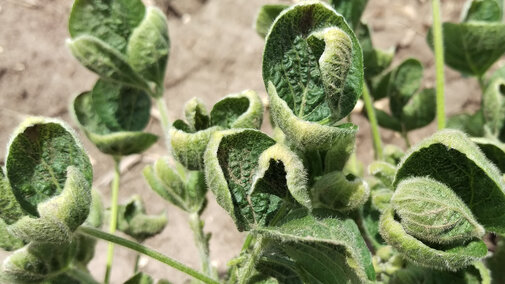Dicamba- and glyphosate-resistant soybean, also known as Roundup Ready 2 Xtend soybean, became commercially available for the 2017 growing season. About 500,000 acres were planted with Xtend soybean in Nebraska in 2017 growing season. Three dicamba-based herbicides — XtendiMax, FeXapan, and Engenia — are labeled for application in Xtend soybean. They can be applied pre-plant, pre-emergence, or post-emergence until R1 soybean growth stage (beginning of flowering).

In summer 2017 dicamba off-target injury issues started the first week of July and continued until the end of August. Non-Xtend soybean are very sensitive to dicamba. Upward leaf cupping is a typical symptom of dicamba in soybean (Figure 1). Nebraska Extension received 348 dicamba-related non-Xtend soybean injury complaints (Figure 2), primarily in the eastern half of the state. The Nebraska Department of Agriculture (NDA) has the legal authority to investigate pesticide-related injury issues. It received 93 off-target complaints in non-Xtend soybean.
Most soybean with dicamba injury recovered and produced pods with no impact on yield, except one field that I know of in Nebraska where there was about a 25 bushel/acre yield reduction. The grower contacted a crop insurance agent, but was not able to settle the claim because the damage was from chemical injury rather than the insured causes. Regardless of impact on yield, off-target movement of any pesticide is a concern.
New Label Requirements for 2018
After considering the off-target injury issues in the 2017 growing season, the United States Environmental Protection Agency (USEPA) has declared new dicamba products (XtendiMax, FeXapan, and Engenia) as Restricted Use Pesticides – for use only by certified applicators. The new label adds requirements for
- dicamba spray application training,
- record keeping,
- wind speed limitations (3 to 10 miles per hour),
- application timing restrictions and more.
The 2018 season is the second in the two-year temporary registration granted by the USEPA to Engenia, FeXapan, and XtendiMax. A recent survey of Nebraska soybean growers conducted by UNL weed scientists reported that more Xtend soybean will be planted in the 2018 growing season. Nebraska soybean growers planting the restricted use dicamba-resistant herbicides will be required to complete dicamba training and, as always, follow the new label requirements.

